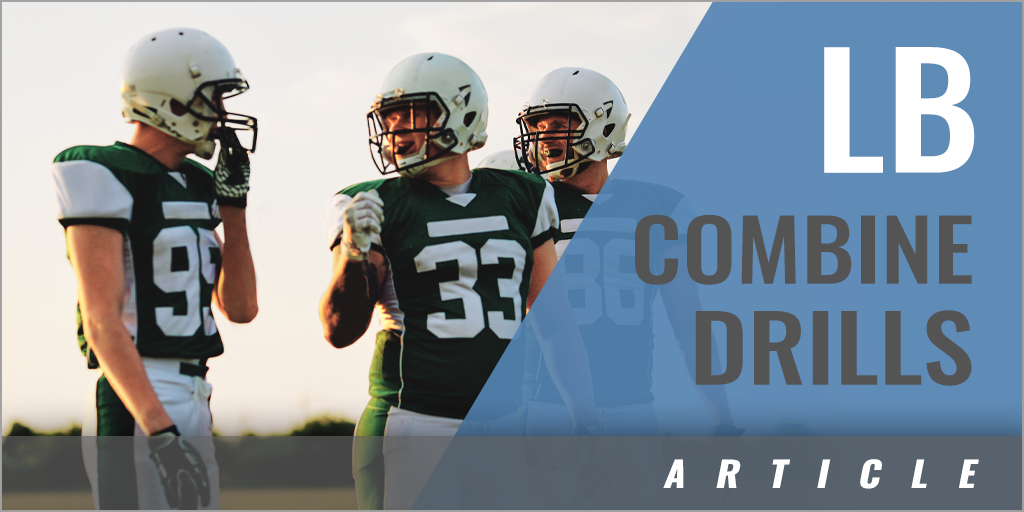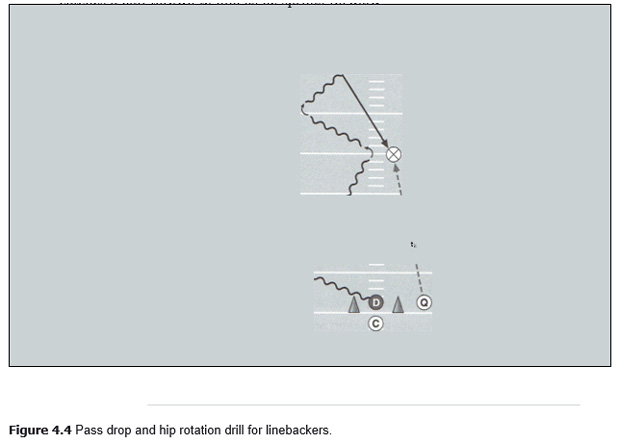|
By: Loren Landow & Chris Jarmon Originally Published in: All-Pro Performance Training Provided by: Human Kinetics The top KPIs for linebackers are lower-body explosiveness, acceleration, and change of direction. These drills reveal how well a linebacker can swivel his hips and change directions, then reaccelerate and close on a position. PASS DROP AND HIP ROTATION Execution To demonstrate their pass coverage abilities, linebackers must be able to move well in space. To simulate a zone coverage, the player will begin directly in front of the coach. At the coach's cue, the linebacker drops into a crossover run moving backward at a 45-degree angle. After the player reaches a depth of roughly 5 yards, the coach will point the ball in the other direction. When the linebacker sees the coach move the ball, he reacts by planting his outside foot, then flips his hips to transition his drop. He still uses crossover steps, now dropping back at a similar 45-degree angle in the opposite direction (figure 4.4). The coach will give two more signals to change direction by moving the ball back and forth, with the player quickly responding to drop in the signaled direction. Then the coach will pull the ball in toward himself, at which point the player makes one last plant step to break on the ball and catches a ball thrown to him as he sprints forward.
PASS RUSH DRILL Execution The pass rush drill is conducted for both outside linebackers and defensive linemen at the NFL combine. The drill is set up with a mirrored layout so that players can complete one repetition each on the left and right sides. A coach is situated directly between the hashes, holding a ball or a snapper stick (a football attached to a stick) to establish a line of scrimmage. One starting cone is placed at each hash, aligned evenly with the ball (figure 4.5). For his first repetition, the player assumes his pass rushing stance at the left-side cone. One standing heavy bag is situated across the line of scrimmage from the player and slightly to his right; these tall, cone-shaped bags contain a heavy spherical rubber bottom, which helps them pop back up to an upright position after being hit. The coach will move the ball to signal the start of the drill, at which point the player executes his get-off from the line of scrimmage. He clubs and rips through the first bag and then through a second bag placed 4 yards behind the first. After clubbing and ripping past the second bag, he turns the corner and sprints to his right to flatten out his path to the quarterback. The rusher sprints all the way through double cones placed on the opposite hash to finish the drill. For his second repetition, the rusher now lines up at the right hash, with the ball to his left. As he comes off the line from the right side, the rusher will club and swim around the first bag as well as the second bag (placed 4 yards behind the first). He now flattens his pursuit to the left, finishing through the double cones to end the drill.
FOUR-BAG SHUFFLE DRILL Execution The linebacker begins in a two-point stance, next to a cone placed 2 to 3 yards behind and to the left of a series of four football agility bags (figure 4.6). These bags are a trapezoidal shape, roughly 4 feet long and a foot tall. The agility bags are lined up in a parallel sequence, with 2 to 3 yards between bags. The player faces in the coach's direction throughout the drill. At the coach's signal, he sprints at an angle toward the inside edge of the bag closest to him. Still facing forward, he moves left around the first bag's top edge, then backpedals between the first and second bags toward the bottom of the second bag. He moves around the bottom of the second bag to its left side, then transitions back into a forward sprint between the second and third bags. At the top of the third bag, he maneuvers around the top of the bag into another backpedal between the third and fourth bags. As the linebacker moves around the bottom of the fourth bag and reaches the fourth bag's left side, he transitions into a lateral stepover across the middle of each bag. Still facing forward, he steps over the bag one foot at a time, leading with his right foot and following with his left foot. He quickly repeats this lateral stepover sequence across all four bags until he steps back across the bag closest to his initial starting position. Now back on the right side of the bag closest to his starting cone, the player quickly positions himself behind the bag, then shuffles left in a straight line behind the series of bags. As he shuffles across, he bends to slap each bag with both hands. As he reaches the leftmost bag and contacts it with his hands, the player sprints around the left side of the bag at a 45-degree angle through the designated finish line. This is a timed drill that displays the linebacker's short-area quickness, bend, change of direction, and lower-body explosiveness.
|









